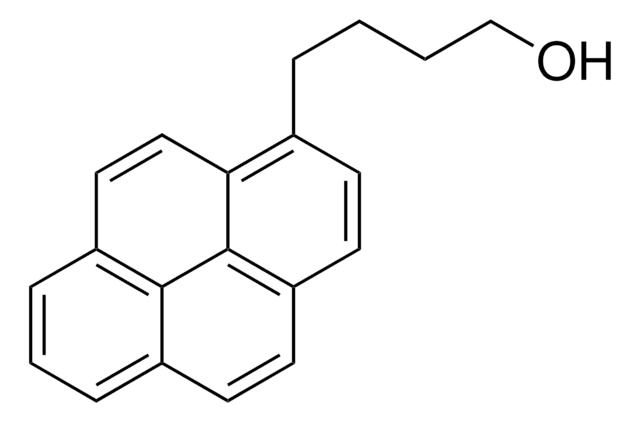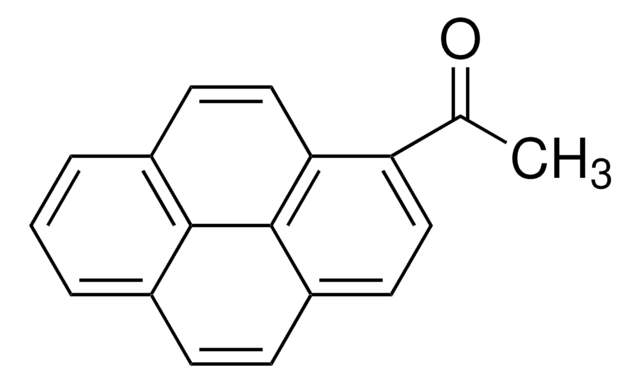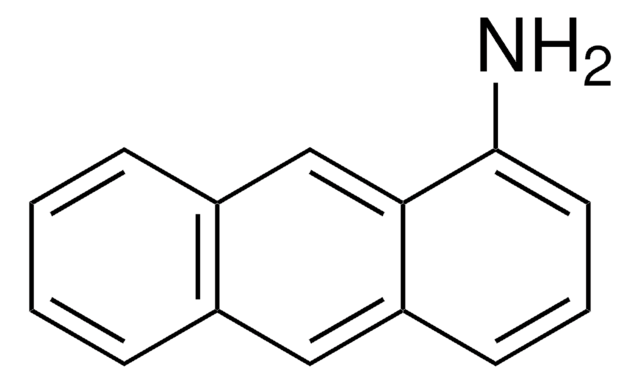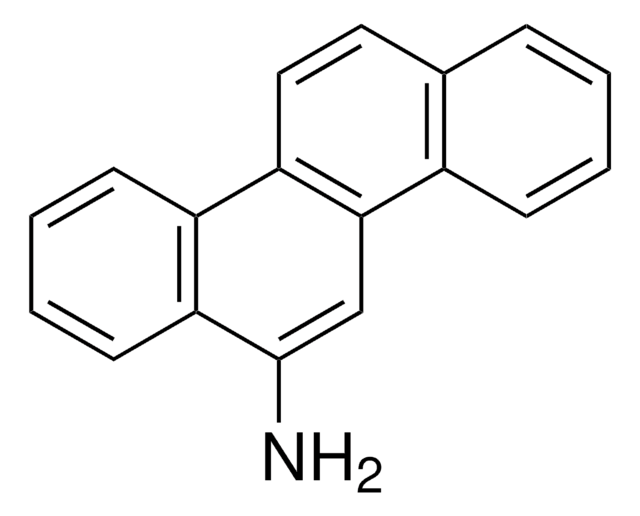401633
1-Pyrenemethylamine hydrochloride
95%
Synonym(s):
PMA
Sign Into View Organizational & Contract Pricing
All Photos(2)
About This Item
Empirical Formula (Hill Notation):
C17H13N · HCl
CAS Number:
Molecular Weight:
267.75
MDL number:
UNSPSC Code:
12352100
PubChem Substance ID:
NACRES:
NA.22
Recommended Products
Assay
95%
form
powder
mp
258 °C (dec.) (lit.)
SMILES string
Cl[H].NCc1ccc2ccc3cccc4ccc1c2c34
InChI
1S/C17H13N.ClH/c18-10-14-7-6-13-5-4-11-2-1-3-12-8-9-15(14)17(13)16(11)12;/h1-9H,10,18H2;1H
InChI key
RGNMXKKNDSHTFD-UHFFFAOYSA-N
General description
1-Pyrenemethylamine hydrochloride is an organic building block.
Application
1-Pyrenemethylamine (PyNH2) has also been used for the synthesis of:
It can also be used for the synthesis of 4,6-dichloro-2-pyrenemethylamine-1,3,5-triazine, a precursor to synthesize a star shaped polymer 4,6-bis(9H-carbazol-2-yloxy)-2-(pyrenemethylamine)-1,3,5 triazine (TPC).
- Pyrenyl hyaluronan (Py-HA), a pyrenyl-based polymer that can be used for the development of pH-triggered drug carriers.
- An electrochemical electrode of reduced graphene oxide bound with pyrene functionalized folic acid derivative.
It can also be used for the synthesis of 4,6-dichloro-2-pyrenemethylamine-1,3,5-triazine, a precursor to synthesize a star shaped polymer 4,6-bis(9H-carbazol-2-yloxy)-2-(pyrenemethylamine)-1,3,5 triazine (TPC).
1-Pyrenemethylamine hydrochloride (PyNH2) has been used for the loading of human telomerase reverse transcriptase (hTERT) small interfering RNA (siRNA) to the functionalized graphene oxide (GO) for the tumor targeting delivery of siRNA.
1-Pyrenemethylamine hydrochloride has been used in the preparation of 1-pyrenemethylamine. It may be used for the noncovalent functionalization of SWNTs with cationic moieties which binds strongly to the negatively charged phosphate backbone of the DNA. It may be used in the preparation of the following Schiff-base ligand:
- pyren-1-ylmethyl-[2-(6-{2-[(pyren-1-ylmethylimino)-methyl]-phenoxymethyl}-pyridin-2-ylmethoxy)-benzylidene]-amine
- 2(pyren-1-ylmethyl-{2-[6-(2-{[(pyren-1-ylmethyl)-amino]-methyl}- phenoxymethyl)-pyridin-2-ylmethoxy])-benzyl}-amine
Signal Word
Warning
Hazard Statements
Precautionary Statements
Hazard Classifications
Eye Irrit. 2 - Skin Irrit. 2 - STOT SE 3
Target Organs
Respiratory system
Storage Class Code
11 - Combustible Solids
WGK
WGK 3
Personal Protective Equipment
dust mask type N95 (US), Eyeshields, Gloves
Certificates of Analysis (COA)
Search for Certificates of Analysis (COA) by entering the products Lot/Batch Number. Lot and Batch Numbers can be found on a product’s label following the words ‘Lot’ or ‘Batch’.
Already Own This Product?
Find documentation for the products that you have recently purchased in the Document Library.
Customers Also Viewed
Reactively formed block and graft copolymers as compatibilizers for polyamide 66/PS blends.
Jeon HK, et al.
Polymer, 45(1), 197-206 (2004)
Sudarat Yenjai et al.
Journal of photochemistry and photobiology. B, Biology, 173, 35-42 (2017-05-30)
A new photochemical reagent, succinic acid-1(1-pyrene)methylamide (PMA-SUC), was developed to recognize the specific binding sites on model proteins, egg-white lysozyme and avidin. The interaction of the photochemical reagent with the proteins was studied by UV-Vis, fluorescence spectroscopic methods and docking
Fabien Giroud et al.
Biosensors & bioelectronics, 87, 957-963 (2016-09-26)
We report the functionalization of multi-walled carbon nanotubes (MWCNTs) electrodes by a bifunctional nitroaromatic molecule accomplished via π-π interactions of a pyrene derivative. DTNB (5,5'-dithiobis(2-nitrobenzoic acid)) has the particularity to possess both electroactivable nitro groups and negatively charged carboxylic groups.
Liwei Hui et al.
ACS nano, 14(10), 13047-13055 (2020-10-14)
We demonstrate area-selective atomic layer deposition (ALD) of oxides on DNA nanostructures. Area-selective ALD of Al2O3, TiO2, and HfO2 was successfully achieved on both 2D and 3D DNA nanostructures deposited on a polystyrene (PS) substrate. The resulting DNA-inorganic hybrid structure
Intramolecular excimer formation and sensing behavior of new fluorimetric probes and their interactions with metal cations and barbituric acids.
Lodeiro C, et al.
Sensors and Actuators B, Chemical, 115(1), 276-286 (2006)
Our team of scientists has experience in all areas of research including Life Science, Material Science, Chemical Synthesis, Chromatography, Analytical and many others.
Contact Technical Service
















